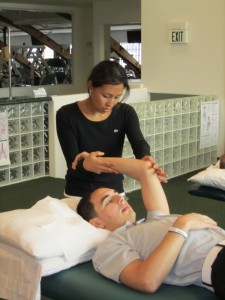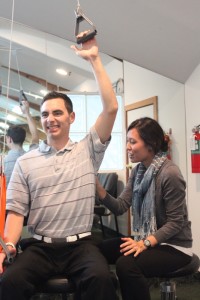You’re outdoors at dawn, the golf course looks beautiful in the sunrise and the grass smells great, but pain distracts you. Here are some helpful quick fixes for while you’re on the links.
Back Pain:
- Bend your knees when retrieving your ball
- Considering using a putter with a longer shaft
- Slow down the backswing to reduce rotational stress on the lower back
- Don’t hyperextend your spine on the follow-through
- Don’t place your feet too far apart as you address the ball
- Crouch into a squat and round your back as much as possible for a stretch
Knee Pain:
- Consider switching to spikeless shoes to reduce twisting forces on the knees
- When recovering from knee injury or surgery, place with short irons to minimize stress on the knees
- Don’t return to full swinging prematurely after injury or surgery – start slowly and work into the game gradually to prevent re-injury.
- Wear a knee brace during the game or practice session
- Ice after playing
Golfer’s Elbow:
- Ease grip pressure and loosen both elbows during the swing
- Bring the club back slowly during the backswing
- Avoid contact with rocks, sprinkler, or tree roots
- Tee-up the ball on fairway shots to prevent divots
- Don’t decelerate the club before impact with the ball
- Ice your elbow before and after play
Shoulder Pain:
- Learn some basic shoulder stretches to do before every game or practice session
- Slow the backswing to reduce stress on the shoulders
- Maintain strength and flexibility of both shoulders
- Sweep the ball off the turf to reduce the chance of impact from divots
- If you have even minor shoulder pain ice before and after play
Some injuries are stubborn enough that you must seek further help. Physical therapy can provide a “jump start” to healing all of the above conditions. CompletePT provides physical therapy with licensed physical therapists in Los Angeles, CA.
Our 92-degree, salt-water pool is a restorative environment for sore shoulders, backs, elbows, and knees. Running and walking in deep water helps maintain fitness while knee, foot, hip, or back injuries heal. Physical therapy exercises to challenge core muscles improve the long-term outcome of back injuries. Specific resistance exercises against the water simulate the golf swing, allowing for maintenance of skill and technique while increasing the strength of the exact muscles needed for that movement. Skilled soft tissue mobilization can relieve the tension in muscles and tendons, especially effective with shoulders and elbows.
Matt Smith golfed at Loyola Marymount University. He tore his labrum while also damaging his rotator cuff muscles. While much of his therapy was skilled manual therapy by his licensed physical therapists, he also enjoyed getting in the warm water. Matt said, “I was able to do a bigger range of motion because there’s no gravity in the water. I could mimic the swing. We kept it under the water as long as I could, so I swung only up to shoulder height at first. I could feel the resistance as I shifted my weight and the rotation strengthened my core muscles, especially the obliques that make that movement. By replicating my swing in the safe environment of water, I was able to maintain the coordinated movement of the body working as one well-connected unit. As I healed, I began doing the full swing, both above and below the water.”
“Both pool and land therapy really helped in terms of getting my swing back,” said Matt. I did balancing exercises, I used the Body Blade (therapy equipment), and swung a long plastic pipe to regain the connection between the body parts working as a unit during the swing. I did lunges with a twist, which helped with spine mobility. I would hang from a pull-up bar while the PTs applied pressure from behind to cause a return of my back extension.”
Lynda Huey, M.S., founder of CompletePT and Huey’s Athletic Network, is a former athlete and coach whose own injuries led her into the water to find fitness and healing. She was educated at San Jose State University where she starred on the track and field team during its golden years. Lynda is the author of four books on water exercise and water rehabilitation.







